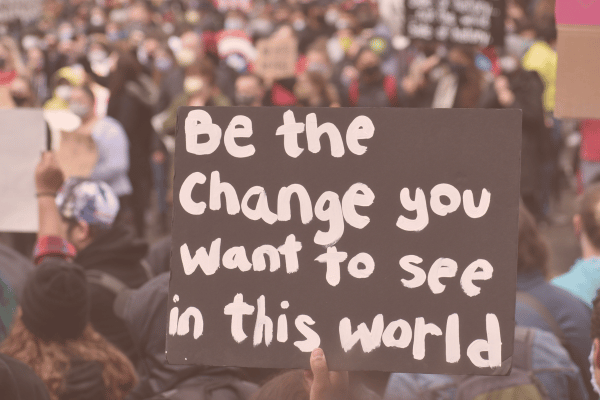The Psychology of Donating
What is behind the phenomenon of “donations” and how do people get involved? You can find out this and more in this article.
For many psychologists, it is always a very interesting phenomenon that people want to help and donate. In particular, they ask themselves what motivates people to put their own interests aside for a moment and do something for other people, often strangers, and make their hard-earned money available for a good cause? We're going to explore this question today.
Why we donate to a good cause - donation motives
Why do we open our hearts and wallets to help others? The reasons why we donate to good causes are varied and profound. In looking at the motives for giving, we explore the psychological, social and emotional drives that motivate us to give and thus become part of something bigger.
The emotional & rational motives behind it
The motives for giving can be roughly divided into emotional and rational motives. It is often a complex interplay of emotional and rational motives that determines whether and for which cause someone donates. A purely emotional motive is to donate out of compassion. In the area of humanitarian aid, such as natural disasters, compassion is one of the main driving forces. Other purely emotional reasons are gratitude and the pure joy of giving and donating. Rational reasons can include tax benefits and material incentives such as the chance to win invitations to events or competitions.
When donating out of a sense of responsibility, i.e. the need to make a contribution such as for research or environmental projects or out of recognition, both the emotional and rational components play a role. Socio-demographic factors such as gender, age, income, religion, marital status, professional status and education also play a role in donations. Some experiments have shown, for example, that women often donate more frequently than men and that the willingness to donate increases with age.
Pure altruism vs. impure altruism
We also rarely act purely altruistically, i.e. for altruistic reasons. Altruistic motives are often mixed with selfish ones. Economists distinguish between two types of altruism. On the one hand, there is "pure altruism", which is results-oriented. Donors derive their satisfaction from the fact that the donation can help those affected. They appreciate what the organization does and are happy about the results of fundraising campaigns.
In "impure altruism", donors derive satisfaction from their own behavior. They derive value from the knowledge that they themselves are helping with the organization's social mission and are acting morally right according to their own ideas. However, this form of altruism is not independent of the recipient's well-being.
One of the leading researchers in the field of donation motivation is Paul Slovic, professor of psychology at the University of Oregon in the USA. He has been researching the psychology of donations for over a decade.
“We help others because it makes us feel good - not necessarily because they need help.”
Paul Slovic Psychology Professor at the University of Oregon, USA
One question is now obvious: Do we only donate to ease our own conscience?
Slovic has studied the question of what influences people's willingness to donate. In one of his experiments, he presented test subjects with a photo showing a starving African girl. One group was only shown this picture, including the girl's name and her biography, while another group saw statistics on the full extent of the famine right next to it: how many people are starving, how many children are falling ill or dying of malnutrition. Those who only saw the picture of the child donated twice as much on average. "We react strongly to individual people in need," says Slovic. "They have a face, a name, a story. Numbers put us off. They don't convey emotions."
When a catastrophe occurs that triggers a large media response, huge sums are quickly raised, as was the case with the terrorist attacks on the World Trade Center and the Pentagon on 11 September 2001. Why, on the other hand, do organizations such as Doctors Without Borders have problems raising enough funds to fight a terrible epidemic such as Ebola? One reason is that there are not many television crews running around West Africa interviewing sick people. In addition, diseases such as Ebola, malaria and AIDS are diffuse problems with no fixed location, and therefore no direct sole point of reference for a donation.
A natural disaster, says Slovic, follows the rules of a story: it has a beginning, it develops in the "main part" and at some point an end is foreseeable. Many serious diseases, on the other hand, are characterized by an open and unknowable end. In addition, Ebola, for example, lacks a drug that effectively combats the disease. "Then a donation feels like a drop in the ocean. You can't observe its effects," says Slovic. "The arithmetic of compassion is strange. And often irrational."
The hurdles on the way to a good cause: obstacles to donations
Despite the desire to support and make a positive difference, donors sometimes face obstacles that prevent them from donating. These obstacles to donating can be many and varied - be it financial constraints, mistrust of organizations or simply ignorance of the need for support. In a brief overview, we want to highlight these barriers and show ways in which they can be overcome.
Excessive demands due to the extent
In an experiment in the US, subjects were divided into three groups and given information about an organization that helps children in the US and around the world. The first group received only general information such as: "Food shortages in Malawi affect more than three million children." The second group was shown a picture of a young Malawian girl named Rokiaand told that the donation could change her life for the better. The result was that the second group donated significantly more than the group that only received general and statistical information. A third group received both the general information and the information about Rokia. They gave more than group 1 but less than group 2, confirming once again that we donate significantly less when we are only confronted with numbers and statistics.
When the donation target is not within reach
It's no secret that we care about the people close to us. So it's no surprise that we are more affected by tragedies the closer they are to us.
Example:
The American people donated $1.54 billion to the tsunami disaster in 2004, which is less than a quarter of the $6.5 billion donated in America to Hurricane Katrina victims. Notwithstanding the fact that the hurricane disaster killed 1600 people, while the 2004 tsunami claimed 220,000 lives.
This fact was much easier to digest before the advent of digital communication. But at a time when we can receive images from all over the world in a matter of seconds, it is much more difficult to comprehend.
The feeling of uselessness of the donation
As mentioned above, we are quickly overwhelmed by the sheer scale of the need. When researchers told study participants in an experiment that several thousand people were in danger in a refugee camp in Rwanda and asked the participants to donate to the refugees, their willingness to donate was linked to how many people they could save in proportion. They were more willing to donate if they could help 1500 out of 5000 refugees than if they could save the same number, but this time out of a total of 10,000 refugees. The smaller the percentage, the less willing they were to donate. Psychologists call this phenomenon "uselessness thinking". Paul Sloviv assumes that this phenomenon is probably linked to a feeling of guilt towards the people who cannot be saved. These feelings of guilt therefore probably have a negative effect on our compassion and altruism.
The dispersion of responsibility
This phenomenon is often referred to as the "bystander effect" and can be easily observed in everyday situations. In short, we assume that enough other people are aware of something and that one of them will do what should be done - like donating to a good cause.
The thought of money
The mere thought of money can also inhibit altruism. In one experiment, researchers trained a group of participants to think about money, for example by placing stacks of money next to them in Monopoly. The control group was not given any money memory aids. The money group showed less cooperation in that they took longer to ask for help with a difficult task. They kept a greater distance from their fellow participants, helped significantly less often and donated less of the money they received for participating in the study. This behavior could be due to people's thoughts of being able to buy something. It is assumed that this feeling limits the willingness to donate. Selfishness is encouraged and the sense of community decreases significantly.
Lack of transparency
Many potential donors are also inhibited by the fear that their donation will not be used efficiently or that it will not be used for its intended purpose. Reports of embezzlement of donations, which keep popping up, further fuel this fear.
“The organization serves as an anchor of trust, its name must vouch for security like a brand.”
Frederyk Meyer Fundraiser Magazin
What can fundraisers do?
Here I would like to show you a few options that you can use to reduce or avoid the defensive reactions that prevent us from donating.
- Images: Use strong images and focus more on individual fates
- Community: Create a sense of community and fairness
Be transparent: Create transparency for the work of the organization and the use of donations - Common ground: Showing the connection between us and people thousands of miles away. We live in one world and are all equally important!
- Influence: Making it clear to donors that their donation is not just a "drop in the ocean"
- Tell stories: Tell powerful personal stories
- Show alternatives: Show other ways to help besides financial donations
- VIPs: Get prominent supporters on board
Talk about your initiatives
There are many different reasons and motivations that prompt people to donate. But no matter the reason, donations are important and can help people all over the world. Some obstacles to donations can be countered with simple measures, others are more complex and difficult to grasp. Many arise from a complex web of emotional and rational motivations that we often do not realize ourselves. Talking about charity can help to create a culture of giving. Showing potential donors that their donation will not come to nothing and that they can make a difference, both in their local community and around the world, can help reduce anxiety. Strong, personal stories help us to understand what we are often no longer able to perceive in the flood of data. With this knowledge and these tips, we wish you continued fundraising success!



